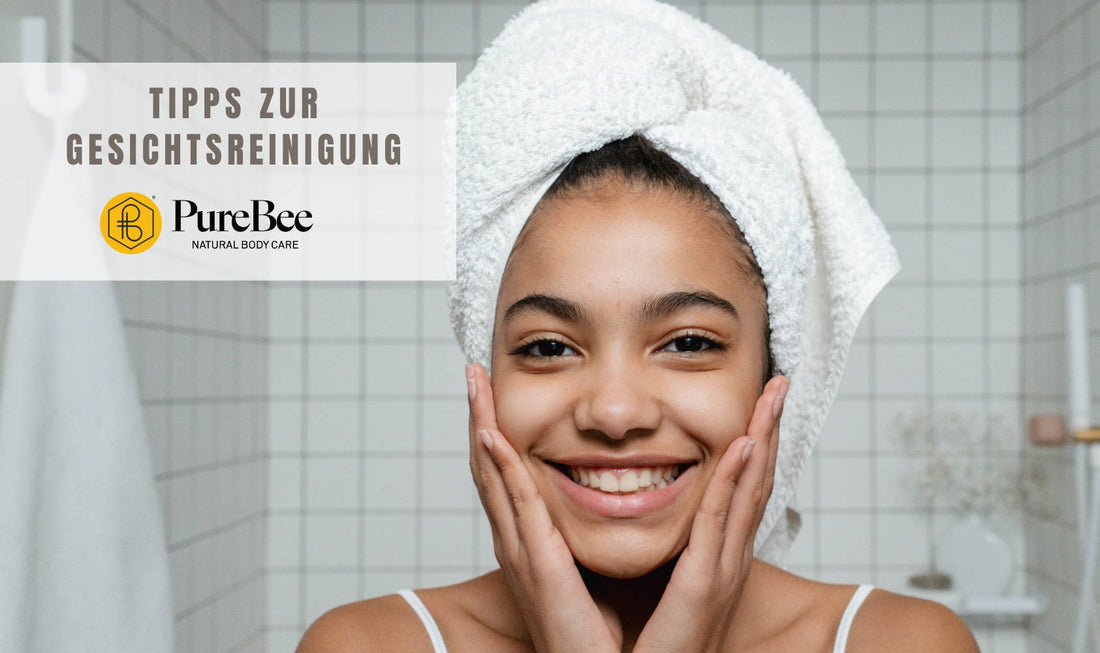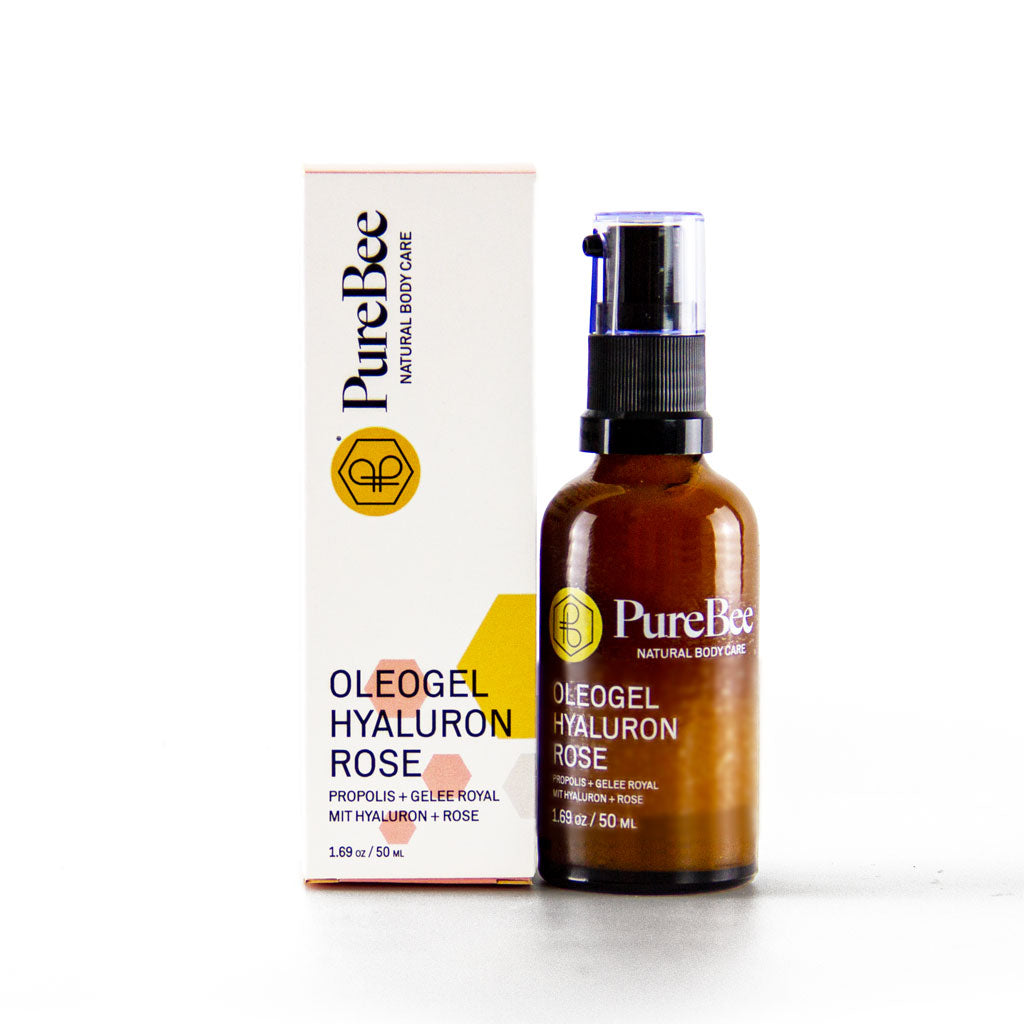Proper cleansing is the basis of any skin care routine and that's why it's so important. You can find an incredible number of different products that promise exactly that. From pads and towels to foams, gels and creams. There is almost no form that does not exist. But not all of these products are gentle and suitable for your skin.

Facial cleansing tips
Share
Pure and clean skin down to the pores - each of us wishes for it! But how do we get them and what might actually do our skin more harm than good? We have put together some tips for healthy and sustainable facial cleansing here.
WHICH PRODUCTS REALLY CLEAN DEEP PORE?
CLEANING IS NOT EQUAL TO CLEANING
The very strong foaming cleansers in particular usually contain very aggressive surfactants that damage your natural skin barrier and dry out the skin as a result. They usually just clean too much and remove the natural protective film and essential oils of the skin. The protective film is broken and leaking, allowing moisture and nutrients to escape from the skin. The skin then needs some time to regenerate and rebuild this protective layer. In the meantime, however, it is very easily attacked, reacts with redness, dry skin and, in the worst case, even with impurities, because bacteria can very easily penetrate the permeable protective layer. The most common indication that cleansing is too harsh for your skin is a feeling of tightness after cleansing. Your skin has been dehydrated. This should not happen with a good cleansing, it should only be freed from dirt and make-up and still be supplied with sufficient moisture and not remove any essential fats.
In general, it can of course be said that aggressive ingredients should be avoided. These easily irritate your skin and in most cases overwhelm it. Even if you usually think less about cleaning products than, for example, about a cream, you should take a closer look at the INCI list (i.e. list of ingredients).
At first glance, all the foreign words and the jumble of letters on the back of the cleaners are more confusing than enlightening for most people. But once you deal with it, it is relatively easy to read out whether the product is actually good for your own skin. On our homepage, we provide a brief explanation of our ingredients for each product and try to provide transparency for all raw materials used. After all, you should also understand what you use to care for your skin on a daily basis.
WHAT ARE THE RIGHT FACE CLEANSING PRODUCTS?
We have also set up a separate page in our shop for our ingredients. In this register you can find out in a relaxed manner what your PureBee products consist of and where you can find information on the individual ingredients.
When shopping online, it is of course relatively easy to find out what certain ingredients do and what they are good for. In the drugstore in front of the shelf it looks a bit more difficult. Since very few of us want to spend hours checking INCI lists in front of the shelves with our smartphones, we generally advise against impulse purchases of cosmetics. But if it does, there are a few ingredients that should set alarm bells ringing.
INCI TRAP - HEALTHY CLEANING OR HARMFUL EFFECT
We would like to show you a few examples here, these are found in cleaning products, among other things, and you should not leave them on your skin.
AGGRESSIVE SURFACTANTS + SULFATE
Examples: ether sulfate, sodium lauryl ether sulfate, PEG-4 laurate, sodium laureth sulfate
Surfactants are found in all skin cleansing products. They dissolve fats and cause washing gel, shampoo or shower gel to foam. A lot of light foam fools us into believing the product would clean particularly well and spread particularly well. One has the feeling one becomes wonderfully clean. However, the downside is that not only dirt and grime, but also important skin fats and moisture are washed out of the skin. But surfactant is not just surfactant. There are also the "good" sugar surfactants that we use in our cleansing oil, for example. They are particularly mild and leave our skin intact.
PARAFFINS
Examples: paraffinum liquidum, ceresin, isoparaffin, ozokerite
Many cleaners also contain paraffins, which in most cases are made from petroleum. These form a film on the skin that shields the skin. That sounds good at first glance, but the problem is that the paraffins can accumulate over time and seal the skin. Then sebum can no longer drain off and the skin can no longer breathe. This creates the perfect foundation for blemishes and dryness.
ALCOHOLS
Examples: alcohol denat, phenethylene alcohol, methanol
“Bad” alcohols, like those listed above, dry out our skin. This can lead to dry skin becoming even drier and oily skin becoming even greasier as it needs to produce more sebum to compensate after dehydration. The emphasis here is on the “bad” alcohols. There are also “good” alcohols that actually care for the skin. These include, for example, pentylene glycol or glycerin, which have a wonderful moisturizing effect. You can find a detailed article on alcohols and a list of “good” and “bad” alcohols in this article .
LIKE DISSOLVES IN LIKE - CLEANSING OIL FOR FACIAL CLEANSING
When developing our PureBee cleansing oil, we made a conscious decision to use an oil rather than a gel. One of the main reasons for this was that it is very gentle on the skin but still cleans thoroughly - deep into the pores but without attacking the sensitive skin barrier. That's why it's suitable for all skin types - and although it's an oil, it's also suitable for oily and blemished skin!
Especially with oily skin, facial cleansing has to be very mild, even if you prefer to scrub and dry it out. Unfortunately, this tends to make the skin worse, because the skin's protective barrier cannot do its job if it is constantly being swollen by aggressive cleaning agents.
WHAT TO DO TO CLEAN PORES?
For those who can still remember their chemistry class, one of the principles may come to mind: "Like dissolves like". It describes the dissolving behavior of substances. For example, substances that are water-based dissolve well in water-based (hydrophilic) solvents. On the other hand, there are fat-loving (lipophilic) substances that dissolve in oily solvents. Many make-up products, creams, but also the dirt from our environment have fat-loving, oily components. With our cleaning oil, we therefore solve the same in the same and break up the dirt particles into their components or loosen them and then simply transport them away as an emulsion with water. And the bacteria that settle on our skin throughout the day and cause impurities are effectively removed with our cleansing oil.
WHAT IS IN THE PUREBEE CLEANING OIL?
Squalane has a very close relative that is found in our skin. The name is just as weird and easily confused - the squalene. This skin's own squalene is an unsaturated fatty acid that is very reactive with oxygen, for example, and has a very short shelf life. Therefore, it is unsuitable for cosmetics production. We therefore use saturated squalene, the so-called squalane. This does not oxidize as quickly, is heat-stable and therefore more durable and effective. However, squalane still offers the same benefits as squalene for our skin. Our vegetable squalane is very similar to the skin's own sebum (tallow). This is mainly because our skin consists of 15% squalene. It has the natural function of protecting the skin from drying out and continuously maintaining the hydro-lipid film. This means that this oil helps to keep moisture in the cells and also prevents the oxidation of the skin's own fats. The skin looks plump and well nourished. Since we find this oil naturally in our body, it is considered to be highly compatible with all skin types.
In addition to these oils, our cleansing oil also contains apricot kernel, almond and jojoba oil . This oil mixture has a high content of vitamins, especially vitamin E, which helps to intercept free radicals (from UV radiation or fine dust, for example) thanks to its antioxidant effect.
Like all cleaners, our cleaning oil cannot do without surfactants for effective cleaning. Natural sugar surfactants (coco glucoside) also help to gently and effectively remove make-up and dirt from a long day. Your skin is so well cared for and pure and feels that way too. Incidentally, sugar surfactants are a great alternative to aggressive surfactants, as they do not bloat the skin and leave the protective barrier and moisture balance intact.
OUR CLEANING OIL
The right basis for every care routine and pore-deep facial cleansing.
REALLY FOR EVERY SKIN TYPE?
By mixing different oils, we can effectively combine their benefits. This creates a holistic effect. Our cleansing oil can therefore respond individually to different skin needs and is suitable for all skin types. Dry skin is supplied with important nutrients and additionally cared for. On the other hand, excess fat is removed from oily skin and replenishment is avoided. Due to the mild formula, the cleansing oil is also suitable for sensitive skin and prevents skin irritation.
AND HOW DO I CLEAN CORRECTLY?
With the cleansing oil you can reliably rid your skin of the dirt and dust of the day or the excess sebum production of the night. You can even use it to gently remove make-up and mascara.
Depending on the skin type, we recommend using the cleansing oil with different frequency
There are also different ways in which you can use the cleaning oil.
Only then wet your hands to emulsify the oil to create a gentle cleansing milk.
You can remove eye makeup with gentle, top-to-bottom movements, but avoid direct eye contact. Then wash your face thoroughly with lukewarm water and gently dab with a clean, dry cloth.
Our cleansing oil leaves no oily film on the skin. This is ensured by the emulsifier polyglyceryl-4 oleate. It connects the oil with the washing water. Hence the milky texture.
THE PATH TO HAPPY SKIN
The basis and the first step for healthy skin is proper and regular cleansing. We hope this article has given you the information you need to perform this step gently but effectively. Our face is one of the parts of the body that is subjected to the most stress. It feels wind and weather as well as UV rays, bacteria, viruses and free radicals. But we also often touch our faces or wear masks that rub against the skin during Corona times. We have to wash off the dirt thoroughly but still not stress the face with aggressive cleaning agents or brushes. Rather rely on a gentle washing ritual and treat your face to a gentle massage. This promotes blood circulation, cleans deep into the pores and cares at the same time. And all this without any stress.

